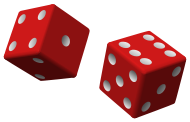- Diceware
-
Diceware is a method for creating passphrases, passwords, and other cryptographic variables using ordinary dice as a hardware random number generator. For each word in the passphrase, five dice rolls are required. The numbers that come up in the rolls are assembled as a five digit number, e.g. 43146. That number is then used to look up a word in a word list. In the English list 43146 corresponds to munch. Lists have been compiled for several languages, including English, Finnish, German, Italian, Polish, Russian, Spanish and Swedish. A Diceware word list is any list of 65 = 7,776 unique words, preferably ones the user will find easy to spell and to remember. The contents of the word list do not have to be protected or concealed in any way, as the security of a Diceware passphrase is in the number of words selected, and the number of words each selected word could be taken from.
The level of unpredictability of a Diceware passphrase can be easily calculated: each word adds 12.9 bits of entropy to the passphrase (that is, log 2(65) bits). Five words (slightly over 64 bits) are considered a minimum length.
This level of unpredictability assumes that a potential attacker knows both that Diceware has been used to generate the passphrase, the particular word list used, and exactly how many words make up the passphrase. If the attacker has less information, the entropy can be greater than 12.9 bits per word.
Diceware passphrases can be difficult to remember and some may prefer other methods, such as using the initial letters of a memorable phrase (for instance, "To be or not to be, that is the question" becomes "Tbontb,titq"). Estimating the entropy of the phrase using the latter approach is more difficult. In this example, the phrase used is very well known (being from Shakespeare) and so is easily guessed, as for instance by using a phrase dictionary. Thus, the entropy of this example is low. Higher entropy can be had from user chosen phrases handled this way, if the user is careful to avoid guessable phrases.
If the length of Diceware passphrases are assumed to be known to an attacker, then the passphrases yield less entropy than the ideal 64.62 bits when used with dictionaries containing variable-length words. This is because the length of the resulting passphrases "leak" information about their composition.
See also
- Brute force attack
- Key size discusses how many bits of key are considered "secure".
- The PGP biometric word list uses two lists of 256 words, each word representing 8 bits.
- S/KEY uses a list of 2048 words to encode 64-bit numbers as 6 English words
- Bubble Babble uses a list of 6 vowels and a list of 17 consonants to encode binary data into pronounceable pseudowords.
References
- Internet Secrets, 2nd Edition, John R. Levine, Editor, Chapter 37, IDG Books, 2000, ISBN 0-7645-3239-1
External links
- English diceware page has the complete description and a word list.
- Dialdice has a nicely formatted word list.
Categories:- Password authentication
- Dice
- Randomness
Wikimedia Foundation. 2010.

